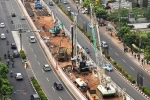Three AP II airports use renewable energy
This article has been translated by PwC Indonesia as part of our Indonesia Infrastructure News Service. PwC Indonesia has not checked the accuracy of, and accepts no responsibility for the content.
Investor Daily - Tiga bandara AP II: Gunakan energi baru terbarukan
2 November 2022
Three airports managed by PT Angkasa Pura/AP II (Persero) use new and renewable energy (NRE) to support their operation. The three airports are Soekarno-Hatta Airport (Banten), Kualanamu Airport (North Sumatra), and Banyuwangi Airport (East Java).
“In the early stage, solar power plants (PLTS) will be utilised by the three airports before being used by all 20 airports. The PLTS construction is carried out gradually until 2025 when all 20 airports will install PLTS with a total capacity of 26.34 MWp (megawatt peak),” AP II President Director Muhammad Awaluddin said in his official statement in Jakarta on Tuesday (1/11/2022).
Awaluddin explained that the construction of solar panels for the PLTS at Kualanamu Airport has been 100% completed to be installed on the cargo terminal and the administrative building (rooftop of 5,100 square metres with a capacity of 761 kilo watt peak). Banyuwangi Airport has also completed their PLTS construction by 100% to be installed on the Airport Rescue and Firefighting Building (rooftop of 600 square metres with a capacity of 35.1 kilo watt peak).
At Soekarno-Hatta Airport, the PLTS construction has reached 90% for the Terminal 2 area, which includes Terminal 2’s linking route (rooftop of 1,400 square metres with a capacity of 309 kilo watt peak) and Terminal 2’s commercial area (rooftop of 4,320 square metres with a capacity of 1,197 kilo watt peak).
“The PLTS construction at Terminal 2 of Soekarno-Hatta Airport complements the PLTS that has a capacity of 241 kilo watt peak that has been operating at Soekarno-Hatta Airport’s Airport Operation Control Centre (AOCC) building,” Muhammad Awaluddin revealed.
AP II is also preparing three important aspects to save energy and achieve global net zero carbon emission, namely human resources who are competent in NRE-based electrical engineering, standard procedures to operate NRE, and technology regarding the use of the suitable platform to operate NRE.
Besides constructing PLTS at airports, AP II is also relying on technology to save electricity to support the application of the green airport concept. AP II has constructed a system called Monitoring System of Airport and Non-airport Threshold Electrical Infrastructure (MANTRI) to control and monitor in real time the use of energy in AP II’s environment.
On the other hand, PT Angkasa Pura II is fully committed to supporting the reduction of carbon emission in the aviation industry. This is in line with the global net zero carbon emission by 2050 program that was proposed by Airport Council International (ACI) and received support at the 41st Assembly of the International Civil Aviation Organisation (ICAO) held from 27 September – 4 October 2022 in Montreal, Canada.
To reduce carbon emission in the aviation industry, AP II is starting to use NRE to support the operation of their airports.
“As stated by ACI, air transportation must reduce carbon [emission] so that they can continue to connect people, the economy, ideas, cultures, and the business world for future generations. AP II fully supports net zero carbon emission by 2050 in the aviation sector by utilising NRE at our managed airports,” Awaluddin stated.
Awaluddin also added that operation and services at AP II airports currently focuses on and considers the environment. AP joins the global community to achieve the net zero carbon emission target in the aviation industry by 2050.


















